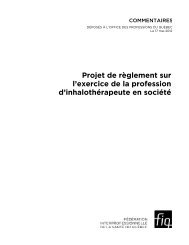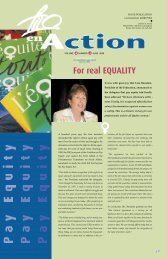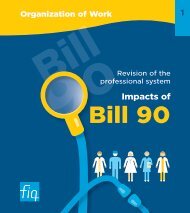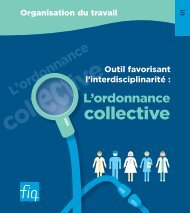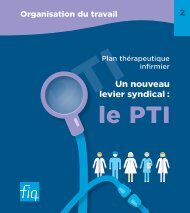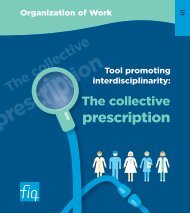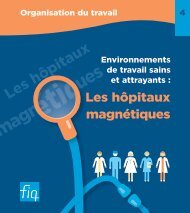WORKPLACE WORKPLACE - FiQ
WORKPLACE WORKPLACE - FiQ
WORKPLACE WORKPLACE - FiQ
- No tags were found...
You also want an ePaper? Increase the reach of your titles
YUMPU automatically turns print PDFs into web optimized ePapers that Google loves.
Follow-upon theSafety Audit<strong>WORKPLACE</strong>SafetyFÉDÉRATION DES INFIRMIÈRES ET INFIRMIERS DU QUÉBECActiTakingn
This booklet, published by the Fédération desinfirmières et infirmiers du Québec, is a joint effortof the Occupational Health and Safety Sector andthe Communication-Information Service.■ Production:Communication-Information ServiceDanielle Couture, consultant■ Written by:Occupational Health and Safety SectorHélène Caron, consultant■ With the help of:Occupational Health and Safety Committee:Sylvie Savard,Executive Committee officer in chargeBenoît DandurandMarie-Josée GauthierDenis NadeauJean RenaudJean-François Tremblay■ Translation:Martine Eloy■ Secretariat:Céline Bourassa■ Graphics:Josée Roy, graphiste■ Illustration:Christian Verreault■ Printing:CaractéraOctober 2003
The final phase of the operation known as WorkplaceSafety: taking action, launched some time ago by theFIIQ 1 , a follow-up of the safety audit recently conducted bythe nurses, is an essential stage in the achievement of the objective ofcreating a safer work environment. Once the potentially dangeroussituations are identified and corrective measures are suggested, whatcan nurses expect? Do nurses have a role to play in the elimination ofthese situations? What are the employer’s obligations in this field? Whathappens if the employer does not act or is slow to act? Do the nurseshave any recourse? How can the union team help them? What can theinstitution’s Joint Committee on health and safety do? Can some safetytips help nurses protect their occupational health and safety?These are questions that can potentially be raised by such an operation,and the FIIQ believes it is important to answer them. The OccupationalHealth and Safety sector, in collaboration with the FIIQ OHS Committee,has produced this booklet to make available to local teams informationthat may prove useful in a context of a dangerous or unsafe situation.Through their collective and individual action, nurses will finally be ableto provide care in a healthy environment, free of any danger to theirhealth, safety, and physical and psychological well-being.1. See the FIIQ brochure Workplace Safety: taking action, distributed in October 2002 during Annual OHS Week 2002 andWorkplace Safety Audit Guide: taking action, distributed in June 2003 for the nurses’ safety audit.1
■ How to apply for intervention by a CSST inspector...(Sections 177 to 193, Act respecting occupational health and safety)■ By an oral or written complaint addressed to a regional office of the CSST 4 .■ The CSST Inspection Service can be reached 24 hours a day.■ The telephone number is indicated in the blue pages of the telephone directoryunder the heading Workplace health and safety.■ Depending on the content of the information transmitted to him at the time ofthe complaint, the inspector will decide on the relevance and timing of his/herintervention in the institution.■ During an intervention, the inspector may verify, in particular, whether thenurse benefits from working conditions that assure her physical and psychologicalhealth, safety and well-being, and whether the employer takes thenecessary measures to protect them; the inspector will issue an inspectionreport and, if he/she considers it advisable, a remedial order requiring theemployer to remedy the situation and fix the time in which he must comply.■ An inspector’s decision takes effect immediately and may be contested within10 days of notice, first to the Direction de la révision administrative (D.R.A.) ofthe CSST and then to the Commission des lésions professionnelles.■ How to apply for intervention by the ASSTSAS...(Policies 2.6 and 2.7 5 of this Association)■ By a joint application formulated in writing, addressed to ASSTSAS and signedby the employer and the unions concerned from the institution.■ ASSTSAS will make no intervention when a complaint has been filed at theCSST Inspection Service, unless the plaintiff’s application is referred to theASSTSAS by the CSST with the consent of the parties.■ ASSTSAS may assist the parties to implement preventive actions with the aimof remedying the situation and permanent measures designed to eliminatehazards to the health, safety and well-being of nurses and employees at thesource.■ ASSTSAS has very interesting expertise, particularly regarding workplace violenceand psychological health.4. Commission de la santé et de la sécurité du travail.5. ASSTSAS policy numbers 2.6 Intervention dans un établissement and 2.7 Demande référée par la CSST.4
■ How to exercise the right of refusal...(Section 12 of the AOHS)■ A worker has a right to refuse to perform particular work if he has reasonablegrounds to believe that the performance of that work would expose him todanger to his health, safety or physical well-being, or would expose anotherperson to a similar danger. The danger must be imminent and not simplypotential or possible.■ This right is subject to two exceptions.The right to refuse may not be exercised:● if the refusal to perform thework puts the life, health,safety or physical wellbeingof another personin immediate danger● or if the conditionsunder which the workis to be performed arenormal in the type heperforms.Although nurses are not excludedfrom the exercise of the right of refusal,these two exceptions gives reason toforesee definite difficulties in a nurse’s abilityto avail herself of this right, given theprofessional obligations set out in her Code ofEthics. She must therefore be very cautious andreserved in using this remedy. Moreover, thisright cannot be exercised as a concerted action,because it is an individual remedy.It is therefore recommended that a nurseconsult her union regardingthe exercise of this remedy.The main steps for exercisingthe right of refusal:■ A nurse who refuses, on reasonable grounds, to perform particular work mustimmediately inform her supervisor or an agent of her employer.■ The supervisor shall then convoke the safety representative, or, if he/she is notavailable, the local OHS representative or the grievance agent to examine thematter and take the necessary corrective measures.■ If there is a disagreement between the employer and the representative regardingthe existence of a danger justifying the refusal or the corrective measuresto be applied to eliminate the dangerous situation, the intervention of a CSSTinspector may be required by the representative, the nurse herself or theemployer.■ The CSST inspector then determines promptly whether or not a danger existsentitling the nurse to refuse to perform her work:● the inspector may order the nurse to resume work;● the inspector may prescribe temporary measures and demand that theemployer implement the necessary corrective measures within such time ashe determines.■ The inspector’s decision must be substantiated and recorded in writing. It takeseffect immediately and may be the object of an application for review to theCSST within 10 days of notice, and then an application to the Commission deslésions professionnelles.5
A nurse is victim of violence at workCan the employer be held liable?The employer may be held liable if it is proven that he did not take the necessarymeasures to offer this nurse a healthy, safe work environment free of all forms of violence.He may also be held liable when he does not react or is slow to react when thisviolent situation occurs.The employer is also liable for faulty acts committedby his employees in the course of their duties. Theemployer may be liable when violent conducthas been practised against a nurse by one ofhis representatives or by a co-worker, if it isproved that this occurred in the course oftheir duties.Consequently, the employer may becondemned to pay compensation asdamages to a nurse who is a victim ofworkplace violence.Among the measures that can betaken by the employer, there are:■ adoption of a policy against violencein the workplace;■ dissemination of such a policy to allemployees including managers, physicians,clientele, visitors, families and volunteers...;■ implementation of an effective internal complaintsprocedure;■ all appropriate measures to put an end to the violent situation;■ ...Since his inaction canbe held against him, theemployer has a great interest intaking the necessary measures to establisha health work environment and eliminate thedangers of assault and violence that may bepresent. In addition to his interest in preventingeventual claims in damages, his intervention mayalso be motivated by the will to reduce the exorbitantcosts generated by workplace violence(loss of motivation, absenteeism, compensation,...)and by the desire to gain from the benefitsassociated with the promotion of health andwellness of nurses and all of his employees(attendance at work, better performance,increased creativity and involvement,motivation, greater interest ininvolvement in their work).A nurse is victim of violence at workWhat recourses can be instituted?In evaluating the recourses that can be instituted by a nurses who is the victim of aviolent incident at work, the presence or absence of a physical or psychologicalemployment injury 6 resulting from this event is a determining factor. In the presenceof such an injury, the only way for this nurse to be compensated is by filing a claimwith the CSST under the AIAOD. In this contingency, she may not institute proceedingsfor damages against her employer, one of his representatives, a colleague or afellow employee.6. An employment injury within the meaning of the Act respecting industrial accidents and occupational diseases (AIAOD):an injury or a disease arising out of or in the course of an industrial accident or an occupational disease, including arecurrence, relapse or aggravation.6
The AIAOD prohibits a person who is a victim of anemployment injury from instituting an action inpublic liability, on the grounds of this injury,against his or her employer, a worker or arepresentative of the employer, for a faultcommitted in the course of their duties 7 . Hereis a table of the various possible remedies:Effective June 1, 2004, theprovisions of the Act respectinglabour standards regardingpsychological harassment will comeinto force. It will then be possible to filea grievance based on the definition ofpsychological harassment prescribedin that law.Range of recourses 8 that may be instituted by a nurse who is a victim of workplace violenceViolent situationresulting inan employment injury■ Filing a claim with the CSST: only possibleremedy to receive compensation.■ Possibility of filing a civil suit: only regardingthis aspect If there is harm to the nurse’sreputation resulting from defamatory statements.■ Filing a grievance or grievances, under thecollective agreement to obtain measuresother than compensation from the arbitrator,such as an order to the employer to: takethe necessary action to put a stop to the violencepractised against the grievor, improvethe climate in the workplace, implement anddisseminate a policy against violence, reinstatethe nurse who is a victim of violence inher position and remove from her personnelfile any document that may be prejudicial toher, etc.■ Filing a complaint with the Commission desdroits de la personne et des droits de lajeunesse: filing such a complaint is possiblebut the results are uncertain in the currentstate of jurisprudence.It is important that the nurse consult herunion before.■ Filing a complaint under Section 32 AIAODor Section 227 AOHS: if workplace harassmentoccurs after an employment injury orthe exercise of a right prescribed in theAIAOD or the AOHS:.■ Filing a complaint with the police.Violent situationnot resulting inan employment injury■ Filing grievances under the collectiveagreement to obtain from the arbitratormeasures such as an order to the employerto: take the necessary action to put a stop tothe violence practised against the grievor,improve the climate in the workplace, implementand disseminate a policy against violence,reinstate the nurse who is a victim ofviolence and remove from her personal fileany document that may be prejudicial to her,etc.The nurse may also, if applicable, call onthe arbitrator, in the drafting of her grievance(s)to award compensatory damagesagainst the employer for the harm sufferedas a result of the violent situation (materialand moral damages, etc.)■ Possibility of filing a civil suit: only regardingthis aspect If there is harm to the nurse’sreputation resulting from defamatory statements.■ Filing a complaint with the Commission desdroits de la personne et des droits de lajeunesse: somewhat uncertain.It is important that the nurse consult herunion.■ Filing a complaint under Section 32 AIAODor Section 227 AOHS: if workplace harassmentoccurs after an employment injury orthe exercise of a right prescribed in theAIAOD or the AOHS.■ Filing a complaint with the police.7. Sections 438 and 442 of the AIAOD.8. If there is a policy to counter workplace violence, it is also possible to file a complaint before the Complaint Committeeof the institution.7
A nurse is faced with a dangerous situationor violence at workHow can the local union team assist her?An essential partner responsible for seeing to the improvement of nurses’ workingconditions, the union team has a primary role in prevention and the elimination ofdangerous or violent situations in the work environment. To this end, the union teamshould:■ Cooperate with the employer to avoid or put a halt, by a appropriate means, to anyform of violence that can be exercised at work regarding nurses;■ Cooperate with the employer to assure protection of physical and psychologicalhealth, safety and well-being of nurses;■ Participate in the development and adoption in the institution of a policy to counterworkplace violence;■ Orient and listen to any nurse who is a victim of a violent situation at work, informher of her rights and remedies and, if need be, refer her to appropriate resources;■ Ensure that follow-up is done after the nurse who is a victim of workplace violencefiles a complaint;■ Advise, assist and support nurses in their applications to the employer and in theremedies that they may institute;■ Intervene with the employer, as the case may be;■ Play an awareness and information role with all nurses and with theemployer, as the case may be;■ Cooperate with the OHS Joint Committee and the variousstakeholders working in the field of occupational health andsafety for nurses and all workers.Nurses also have every interest in informing their union teamof the existence of any dangerous or violent situations at workso that the latter may have an overview of the problem and bein a better position to intervene with the employer, if necessary.By its action, based onfavourable prejudice, theunion team helps nurses dealingwith a dangerous or violent workplacesituation to feel less isolatedand to make decisions more quicklyand effectively regarding the stepsto follow, the people to consultand the measures to be taken.The Federation is committed to fighting all forms of violence.This commitment is in line with the spirit of the Statement ofPrinciple and the Constitution and Bylaws. Consequently, we cannotendorse any form of violence, any aggressive behaviour perpetrated byits members or against its members. 9 Its affiliated unions must therefore includein their own bylaws, a statement of principle denouncing all forms of violenceperpetrated at work, in line with the one in the Federation’s bylaws. It is thereforeessential to appoint a person in the union structure who will be in charge of the issueof workplace violence.9. See Policy to counter violence at work – to work in dignity – Taking action, FIIQ booklet, February 2002, page 198
There are dangerous or unsafe situationsin the institutionWhat can the OHS Joint Committee do?The OHS Joint Committee (OHSJC) has a very important role to play in the identificationand treatment of dangerous or unsafe situations present in the institutions, whichmay not have been resolved by the nurses themselves or by the employer. TheOHSJC, which has an advisory and non-decisional role, will draft an action plan adaptedto the realities of the work environment, which it will propose to the parties toensure a healthier and safer work environment. For this purpose, the Committee, in itsassessment of the problem, may consider information coming from, among othersources: complaints and reports of dangerous or unsafe situations, inspection visitsperformed by a CSST inspector, the register of employment injuries, investigationsand analyses of accidents or incidents occurring in the institution, statistics, etc. Tocarry out its work successfully, it is essential that the various relevant informationsources be made available to the Committee.To be effective in dealing with dangerous situations, the OHSJC must obtain a clearmandate and receive full support from the employer and from the union(s) concerned.For this purpose, the mandate received must be known, understood and accepted byeveryone in the institution, particularly the nurses.The OHSJC will also see to the expediting and follow-up of the recommendationstransmitted to the employer so that the proposed measures are taken within the prescribedor agreed time limits. Following up measures is a very crucial aspect of its role,to prevent the suggested corrective solutions from being forgotten.There are dangerous or unsafe situationsin the work environmentDo nurses have to participate in eliminating them?Joint participation by all players in the work environment (nurses, other employees,employer, unions, managers, physicians, beneficiaries, visitors, families, volunteers…)is essential to eliminate dangerous situations at the source and fight the phenomenonof workplace violence. Solving this problem concerns and should be ofconcern to everyone.Nurses, like the institution’s other employees, must take the necessary measures toprotect their health, safety or well-being in the workplace. They have the duty to participatein identifying and eliminating dangerous situations present in their workenvironment 10 . They must get involved and cooperate in implementing the proposedcorrective measures.It is to every nurse’s advantage to be proactive in the prevention of violence and tomake a deliberate choice to protect her physical and mental health at work. Despiteall the nurse’s good intentions, however, it may happen that she is unable to deal withcertain dangerous or violent situations that may arise at work. This is why joint actionby all personnel and stakeholders is important to eliminate the phenomenon.10. Section 49 of the AOHS sets out the worker’s obligations in matters of occupational health and safety.9
Nurses must protect their health and safety at workHow can they do this?If all personnel are vigilant and proactive, this can make all the differencein countering workplace violence. Reporting an unacceptable situation,breaking the silence, mobilizing, adopting collective strategies for actionand for seeking support are all means of applying zero tolerance anddriving violence out of the work environment. Nurses can follow somesafety tips or measures to help them protect their health, safety andwell-being at work.■ Some safety tipsIn general■ Pay special attention to your work environment, the signs and the safety measuresavailable, places that may serve as hiding places, the layout of the premises,any person who may pose a risk of assault, etc.;■ Do not take any chances in the case of a dangerous situation;■ Do not hesitate to report an unacceptable situation to the employer and yourcolleagues;■ Report any dangerous situation to the employer promptly and inform the unionteam immediately;■ Set your own boundaries between what is acceptable and unacceptable;■ Set up the workplace, such as an interview room, to have immediate access toan exit door so that you can escape quickly and get help;■ Remove any object that can serve as a weapon from the clients’ reach andview, or ask that it be permanently fastened down;■ Ensure that traffic areas in the workplace are not needlessly cluttered;■ When faced with a violent person: leave the premises or exit the room immediatelyand get help;■ Be capable of recognizing the preliminary signs of a crisis and be capable ofcommunicating with an aggressive person;■ Ask to receive adequate training, if needed, regarding workplace violence orintervention with aggressive clients: prevention is the best strategy;■ Take women’s self-defence courses, as needed;■ Establish a team response strategy, in conjunction with all personnel, to applyemergency measures;■ Agree with your colleagues on a code word or phrase to report a dangerous situationand be able to obtain immediate assistance;■ Know the institution’s alarm code for a violent situation. This code is linked toa response team or to a person designated for this purpose. This team or personmust receive adequate training to deal with this kind of situation;■ Inform her female colleagues about the high-risk behaviour of a patient or afamily: place this information well in view in the nursing-care plan and in thepatient’s medical file;10
■ Show solidarity with your colleagues who are victims of workplace violenceand harassment: agree with them on action strategies for dealing with a physician,a manager, an employee or a patient who is potentiallyviolent;■ During darkness and off-peak parking hours,favour a buddy system to accompany each otherto your cars.During home care visits■ Inform your department in advance of your workschedule, the places to be visited, your movementsand how to contact you.■ Before making a home visit: phone the client to confirmthe appointment and verify her condition.■ Once on site, evaluate the situation before entering. Ifthe atmosphere is threatening, it is better to leavethe premises and to seek help.■ Have a cell phone within reach.■ Locate stores and other places in the neighbourhoodwhere it is possible to get help.■ During a home visit, avoid carrying, in your purseor pockets, personal information that could enablean individual to harass or blackmail you.■ Avoid carrying heavy and bulky material that could preventyou from leaving the premises quickly in the event a dangerous situationshould arise.■ Wear appropriate clothing and shoes so that you make a quick exit from thepremises.■ If the premises are potentially dangerous or if a home visit must be made in thedark, have a colleague accompany you.■ Use a means such as a personal alarm or a whistle so that you can make yourselfheard when you are confronted with an emergency while alone.■ Agree on safety instructions with the taxi driver, such as waiting for you duringpotentially dangerous visits.■ Agree with the CLSC on a formula or a call for help code for sending help immediately.■ During a home visit, keep your car keys accessible at all times and park yourvehicle so that you can start it quickly.Caring for people is part of a nurse’s job.Being assaulted, insulted or threatenedby anyone is in no way part of a nurse’s job– and it is unacceptable!11
Reporting a dangerous or unsafe situationIdentify the dangerousor unsafe situationobserved in the workplaceInform her supervisor promptlyof the presenceof this dangerous or unsafe situationComplete theDangerous Situation Report 11blank, suggesting corrective measuresto eliminate this situationTransmit the Dangerous Situation Reportblank to the employerand the union teamThe employer APPLIES the necessaryimprovements and corrective measures toeliminate the dangerous or unsafe situationThe workplace is now safeInform the union team.The employer DOES NOT APPLYthe necessary improvements and correctivemeasures to eliminate the dangerous orunsafe situationNotify the union team who will then transmitthe report to the OHS Joint Committee, if oneexists in the institution or, in its absence,to a CSST inspector. It is also possible toapproach ASSTSAS.11. The FIIQ has produced a Dangerous Situation Report blank, which is available at the union office.12
NURSES’ RIGHTS REGARDING THE PROTECTION OF THEIR HEALTH AND SAFETYUnder the Quebec legislation■ Every person who works has a right to fair and reasonableconditions of employment which have properregard for his health, safety and physical well-being.Relevant provisions■ Section 46 of the Charter of Human Rights andFreedoms (Quebec Charter)■ Every person has a right to the safeguard of his dignity,honour and reputation■ Discrimination and harassment prohibited on the basisof any ground mentioned in Section 10 of the QuebecCharter■ Every employer must take the necessary measures toprotect the health 12 and assure the safety and physicalwell-being of his worker.■ Every worker has a right to working conditions that haveproper regard for his/her health, safety and physicalwell-being.■ The employer must take any measures consistent withthe nature of the work to protect the health, safety anddignity of the employee.■ Every employee has a right to a work environment freefrom psychological harassment.Employers must take reasonable actions to prevent psychologicalharassment and, whenever they becomeaware of such behaviour, to put a stop to it.■ Section 4 of the Quebec Charter■ Section 10 and 10.1 of the Quebec Charter■ Section 51 of the Act respecting occupational healthand safety (AOHS)■ Section 9 of the AOHS■ Section 2087 of the Civil Code of Québec (C.C.Q.)■ Subsection 81.19 of the Act respecting labour standardsThese provisions concerning psychological harassmentwill only come into force effective June 1, 2004.Under the FIIQ Collective Agreement■ The employer takes the necessary measures to preventaccidents, to ensure the safety and promote the goodhealth of employees.■ No nurse shall be subject to sexual harassment in thecourse of her work or to discrimination on the basis ofany grounds mentioned in the collective agreement andin the Quebec Charter (race, colour, sex, pregnancy, sexualorientation, civil status, age except as provided for bylaw, religion, political convictions, language, ethnic ornational original, social condition, a handicap or the useof any means to palliate a handicap, kinship and parentalsituation)■ No nurse shall be subject to violence in the course of herwork.Relevant provisions■ Clause 41.01 regarding occupational healthand safety■ Clause 3.01 regarding discrimination■ Clause 3.02 regarding sexual harassment■ Clause 3.03 regarding workplace violenceThe employer and the union agree to cooperate in orderto prevent or put a halt, by appropriate means, to allforms of violence by drawing up a policy, among otherthings.■ The employer treats his employees fairly.■ Clause 2.0312. The Act respecting occupational health and safety seeks to protect both the worker’s physical health and his/her mentalor psychological health.13
FÉDÉRATION DES INFIRMIÈRES ET INFIRMIERS DU QUÉBECHead Office: 2050, de Bleury, 4 e étage, Montréal (Québec) H3A 2J5Tel. : (514) 987-1141 Fax : (514) 987-7273Quebec City Office: 1260, bd Lebourgneuf, bureau 300,Québec (Québec) G2K 2G2Tel. : (418) 626-2226 Fax : (418) 626-2111web site : www.fiiq.qc.ca ● e-mail : info@fiiq.qc.caAnnual OHS Week2003



